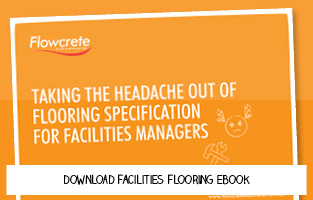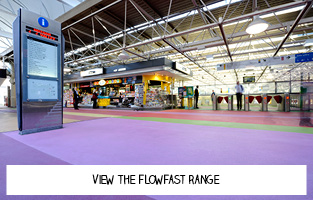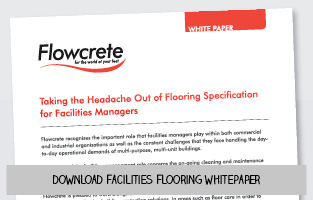Challenges when Choosing a Floor Finish
When specifying a hard flooring surface for a new build or refurbishment project the facilities manager faces a difficult choice.
Multiple factors should be taken into consideration to ensure the floor has the right properties for the building and that it can be installed on schedule and within budget.
In public sector locations the floor has to be able to withstand numerous operational demands, all of which need to be understood during the specification process.
If the wrong product is chosen then it could lead to a number of failures such as disintegration, acid corrosion, thermal shock cracking, discolouration, a slippery, unsafe surface or even an unhygienic environment. On top of this, a floor that takes too long to install could delay the building’s construction schedule - leading to a domino effect of problems including increased downtime and loss of revenue.
During construction or refurbishment many developers worry about leaving a site idle for weeks or months whilst the floor cures. For locations that need an especially robust floor with a thick surface it can take days or even weeks to cure and allow the client a full return to service.
For public sector constructions in particular time is of the essence, with strict deadlines from the government or local authority that have to be met. This means that facilities managers are often faced with the task of speeding up schedules and cutting downtime. To do this they might be tempted to delay replacing a failing floor or opt for lower quality flooring materials that won’t withstand the building’s working environment.
However high speed flooring solutions are available that provide a hard wearing, durable floor with a significantly accelerated resin curing speed.
Methyl Methacrylate (MMA) solutions contain a catalyst that drastically accelerates the speed of cure typically associated with laying seamless poured floors in-situ. This delivers a fully trafficable floor for operational activities or follow on building work only 1-2 hours after application.
Based on a modified acrylic resin formula, this material is ideal for old or new concrete as well as asphalt, tiles, metal or wood. This flexibility saves time, labour and money in refurbishments as it can be applied directly over the existing floor.
When considering a new floor each facilities manager needs to weigh up the cost of downtime against the life-cycle cost of the new floor. Average downtime costs and timetables can vary depending on the sector, size of operation and complexity of the project.
When specifying a floor make sure to conduct a full life-cycle cost analysis that takes into account on-going maintenance, initial installation and end-of-life expenditures. This process helps facilities executives understand exactly what a floor will cost over its lifetime prior to installation, ensuring the floor meets the long-term needs and budget of the project.
An MMA solution not only reduces costs at the start of the process through a reduced construction program, but provides long-term financial benefits when it comes to refurbishing or repairing an existing MMA floor, as a new MMA coating can simply be layered on top of the old. The new layer chemically fuses to the previous floor creating a monolithic system that will not delaminate. This means that floors can be upgraded with a fraction of the cost, time and disruption that it would take to replace an entire floor.
Different building areas need to be designed to cope with the specific challenges they will face. For example public sector services such as the military, fire service and police need strong, durable floors to withstand the heavy machinery, vehicle traffic and general wear typical of these environments. However the kitchen areas of these stations may also need these characteristics but will have hygiene and ease of clean as the main priorities.
Corrosive chemicals in particular are found in many locations and can range from sterilising preparations, oils and fuels, food derivatives, fats, grease and aggressive acids, alkalis and solvents.
A floor needs to be able to resist the level of chemical attack that it will be subjected to so that it can protect the building’s concrete substrate and structure. Corroded floors also become hygiene hazards as bacteria can build up within surface cracks. Hospitals with specialist chemicals in particular need to be aware of how the floor they choose will react if exposed to the corrosives.
MMA floors stand up well when faced with a wide range of chemicals including most organic and mineral acids, alkalis, salt solutions, natural oils and fats, disinfectants, cleansers and caustic soda. They are also unlikely to stain or discolour, which is very useful in areas where liquid on the floor is common, such as swimming pools, life boat stations and shower rooms.
The health and safety profile of a floor can be improved with anti-slip aggregates. This is ideal in slippery work environments to avoid the risk of falls which can lead to serious injuries that cost employers and the health service, damage products or equipment, delay work or in extreme cases impair the facility’s reputation. Textured quartz beads are used to provide traction underfoot in locations where the floor undergoes significant abuse or gets very wet.
Rigorous hygiene standards are enforced in many locations, especially healthcare environments. MMA systems provide seamless, impermeable surfaces that are easily cleaned and because it is unlikely to crack bacteria cannot accumulate in hard to clean gaps in the floor.
When specifying a new floor, take time to discuss the planned cleaning regime with the manufacturer to ascertain if the solution can handle the level of maintenance and on-site cleaning chemicals.
MMA resins provide design and pattern opportunities not possible with other alternatives and it retains colour vibrancy due to its hard coating. These materials can be colour matched to neighbouring surfaces to have a positive impact on operational management through colour zoning, navigational signage and safety measures.
Selecting and installing flooring is a complex process that starts during design and affects the building throughout its lifetime. Each day, walking through the building, the owner and occupants will see the floor surfaces and the results of choices made even before construction began. Take care to consider any new material carefully because although often overlooked, no other surface in a building gets as much use as the floor.




